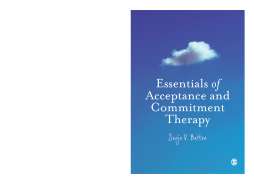
Additional Information
Book Details
Abstract
'The literature on Acceptance and Commitment Therapy (ACT) is vast but if you want to dig down to the essentials of ACT you've found the right volume. Nothing central is left out and nothing unnecessary is left in. Written by one of the world's experts on ACT, this book delivers. Highly recommended.' - Dr Steven C. Hayes, Foundation Professor, University of Nevada
This practical, easy-to-use book introduces the theory and practice of Acceptance and Commitment Therapy (ACT), a key contextual third wave CBT approach. The book takes the reader through the therapeutic stages from start to end, showing how to use acceptance and mindfulness together with commitment and behaviour change strategies to improve mental health. This is a uniquely concise and clear introduction that does not require prior knowledge of the approach. It
" puts the emphasis on practical interventions and direct applicability in real practice
" avoids jargon and complex language
" is full of case examples to translate the theory into practice
" includes key points and questions to test readers' comprehension of the topics covered.
After reading this book, readers will be able to apply basic ACT interventions for common problems, and will know if they are interested in more in-depth training in ACT. This is a must-have overview of ACT for CBT trainees on graduate level courses in the UK and worldwide. It will also be of value to practitioners on ACT workshops and short courses, as preliminary or follow-up reading.
This book is a must for clinicians who are interested in learning about ACT. It is well written, practical, therapist friendly and very well organized. It provides therapists with practical guidance that can be used in clinical situations. It could easily be used as a textbook to support ACT training and supervision.
Dr. Kirk Strosahl
Psychologist, Central Washington Family Medicine, Yakima, Washington
A concise and accessible guide to Acceptance and Commitment Therapy for practitioners interested in learning about this innovative and clinically powerful approach to psychotherapy. Dr. Batten draws on her extensive experience as a clinician, supervisor and trainer, to provide readers with the solid foundation they need to engage in case conceptualization and treatment planning from an ACT perspective. Her inclusion of key concepts, key terms and points for review and reflection make this an outstanding text for graduate-level trainees.
Dr. Susan M. Orsillo
Professor and Director of Clinical Training, Suffolk University
If you are looking for a clear, nuanced, and intensely practical introduction to ACT, then start with this book. Sonja has been living and breathing this work for a very long time and it shows on every page. Guided by her gentle hand, you'll be offered a unique perspective on the thinking processes that underlie effective ACT work and come away with a deeper appreciation of ACT itself. I consider this book an essential read for anyone serious about learning ACT. I am already planning to use this book as a teaching tool with my graduate students and those I supervise in clinical training.
John P. Forsyth,Ph.D.,
Professor and Director of the Anxiety Disorders Research Program at the University at Albany, SUNY, and author of Acceptance and Commitment Therapy for Anxiety Disorders, The Mindfulness & Acceptance Workbook for Anxiety, & Your Life on Purpose.
Batten's world-wide reputation as an expert ACT trainer shines through in this thorough, practical and clearly written book. Her deep understanding and long experience with ACT has allowed her to produce an insightful clinical guide that those developing their ACT skills will find essential. Dr. Batten presents the key ACT concepts in a way that makes them easy to understand and apply therapeutically. I have no doubt that this book will serve as a key ACT text throughout the UK and Europe.
Professor Frank W. Bond, PhD
Head of Department, Department of Psychology, Goldsmiths, University of London
This is the best introductory guide to acceptance and commitment therapy (ACT) that I have seen. Both the theory and techniques of the ACT model of psychotherapy are often counterintuitive and confusing, even to experienced therapists. Many existing books on ACT delve into thorny theoretical issues that are only fully appreciated by those already familiar with the model, and that leave those without a thorough grounding scratching their heads in bewilderment. This book fills an important gap. Batten nicely distills the essence of ACT's core ideas in this lucid, highly accessible book. This book will be required reading for my doctoral students in clinical psychology, and I highly recommend it to any clinician seeking a clear introductory treatment to this groundbreaking work.
James D. Herbert, Ph.D.,
Professor of Psychology, Associate Dean for Research and Graduate Education and Director, Anxiety Treatment and Research Program, Drexel University.
